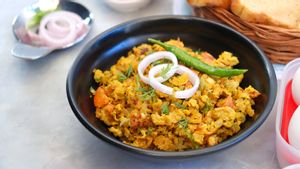Parsi cuisine is the perfect amalgamation of culinary influences from India and Persia. It’s a unique concoction of what the Parsi community enjoys, however it’s unlike the cuisine you’d find in Persia or modern-day Iran. Eerily similar to certain Indian dishes but the similarity stops after a point, making Parsi food a niche on its own. While a handful of dishes have become incredibly popular like dhansak and salli chicken, there are still many interesting recipes that haven’t gone mainstream but you’ll find them in almost every Parsi household.
Parsi food is best described as ‘khatoo mithoo tikhoo’—which translates to sour, sweet, and spicy. While most dishes incorporate this holy trinity of flavours, it’s perhaps the most prevalent in our pickles. All of India has its own version of achar and the Parsi community has some very distinct ones.
1. Lagan nu achar
This is probably the most popular and commonly heard pickle because as the name suggests it’s a pickle served at a Parsi wedding. Often called Gajar Mewa Nu Achar, this humble mixture of carrot, raisins, sultanas, figs, and apricot is a predominantly sweet pickle and the opening act at any Parsi wedding feast. This achar is the first thing that’s served on the patru (flat banana leaves which the entire meal is eaten off of, as it’s served course-wise). The carrot, raisins, and apricots lend a distinct sweetness to this pickle but it’s got subtle sour and spicy notes from the vinegar and spices added to it. It’s a staple in most Parsi homes and works well even with a simple plate of steamed rice and yellow dal.
2. Garab nu achar
This is one of the most interesting pickles in the Parsi repertoire. Garab meaning fish roe in Gujarati is actually the bhing nu garab or the fish roe specifically from hilsa or herring fish. Garab is also sometimes referred to as the fish roe from the ‘boi’ river fish (mullet) found in Gujarat but it’s usually the bhing that most people use to make this pickle. Not exactly the Parsi caviar equivalent—this pickle consists of fish roe, mustard, and sugarcane vinegar that’s a distinct ingredient in most Parsi dishes and spices. There’s no ‘mithoo’ in this recipe so it’s a spicy sour mix on your palate and one that is eagerly sought after.
3. Sukka boomla nu patio
This is a delicacy from Tarapore, a small town in Gujarat and is often called the Tarapori boomla nu patio. It’s made from dry Bombay Duck fish and is relished with much gusto. The interesting thing about this pickle is that it’s also served as a dish, not just a condiment. It’s made with sticks of fried Bombay Duck (yes, it’s a fish and not an actual duck) along with a lot of oil, jaggery, red chillies, garlic, and Parsi-style sugarcane vinegar. The chilies garlic and other spices are ground into a thick fiery paste and then cooked in oil, jaggery, and lots of vinegar before tossing in the boomla. Once it’s cooked and cooled down, it’s bottled and kept for months to treasure with your meals. However, when this is made in my household it’s usually wiped out in two days!
4. Baffenu
I’ve seen mango pickled in many houses but none quite like this Parsi baffenu. It’s a unique pickle which, much like the boomla nu patio, is eaten as an accompaniment or as a dish in itself almost like a vegetable. This double role is perhaps its greatest appeal because this pickle can last for months if stored well. The process is interesting where ripe avocado mangoes are boiled or pressure cooked and then left to dry naturally. It’s this drying process that is crucial as there shouldn’t be a drop of moisture on the mango or it will attract fungus eventually. To this, a mixture of vinegar and mustard powder along with oil, garlic, chilli powder, and turmeric is carefully poured all over the cooked mangoes. It’s left to ferment and once in a while, you are meant to gently, ever so gently, spoon the oily mixture over the mango again. Fifteen days later it’s ready to feast on. Trust me, this is a tricky process so if you find a generous Parsi friend who makes this at their home, ask for your own jar to sample.




